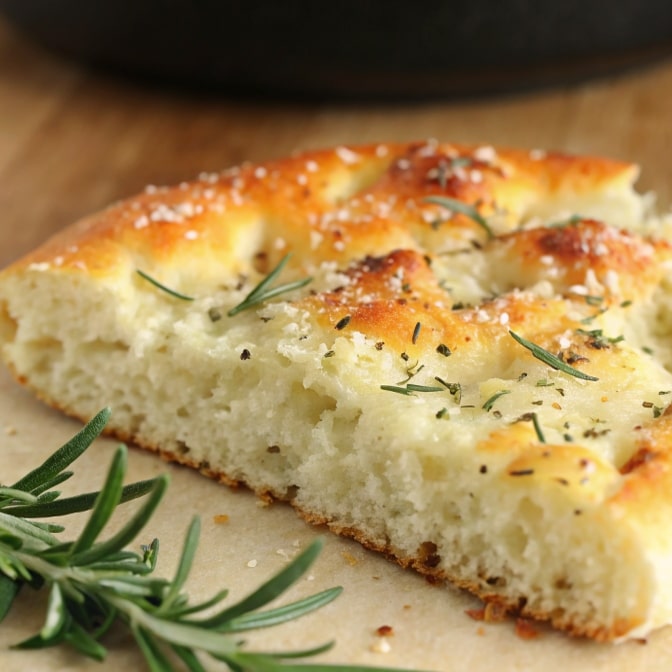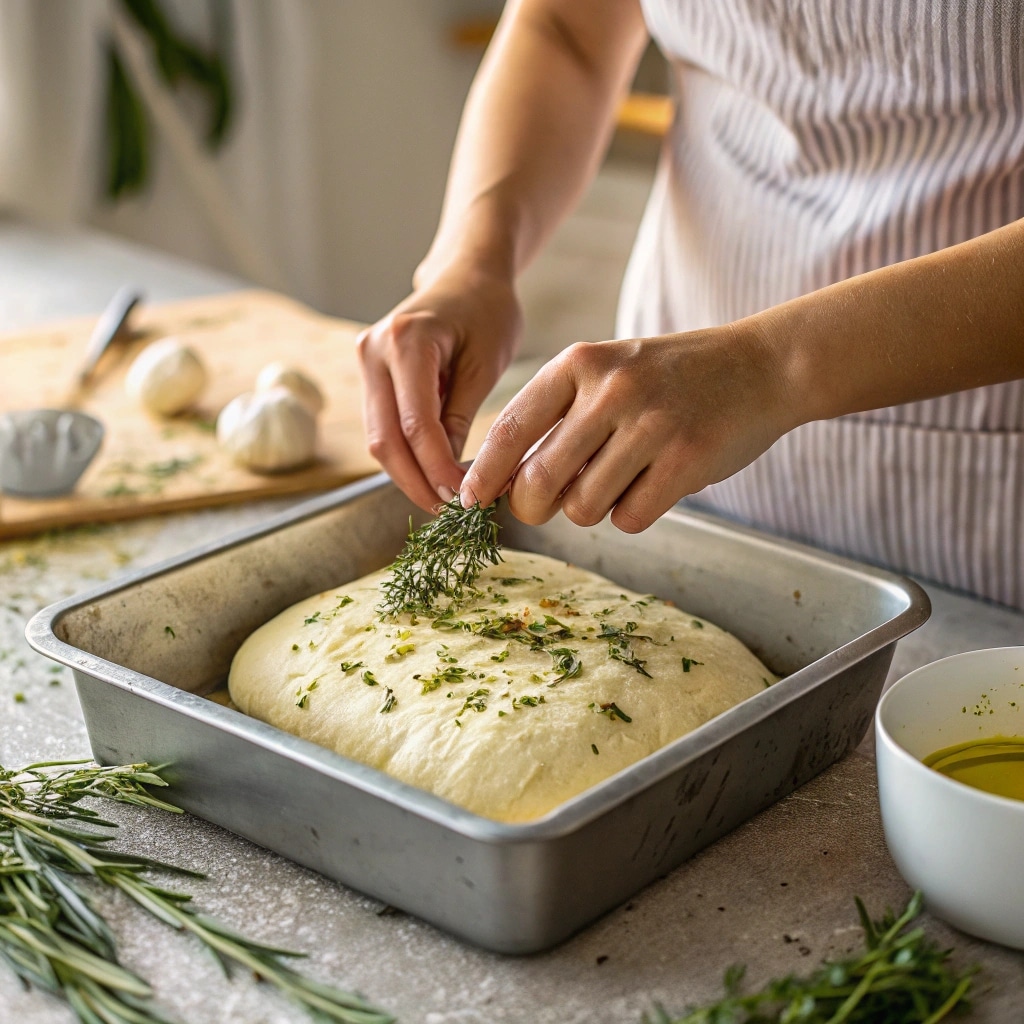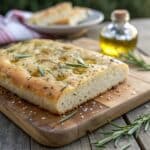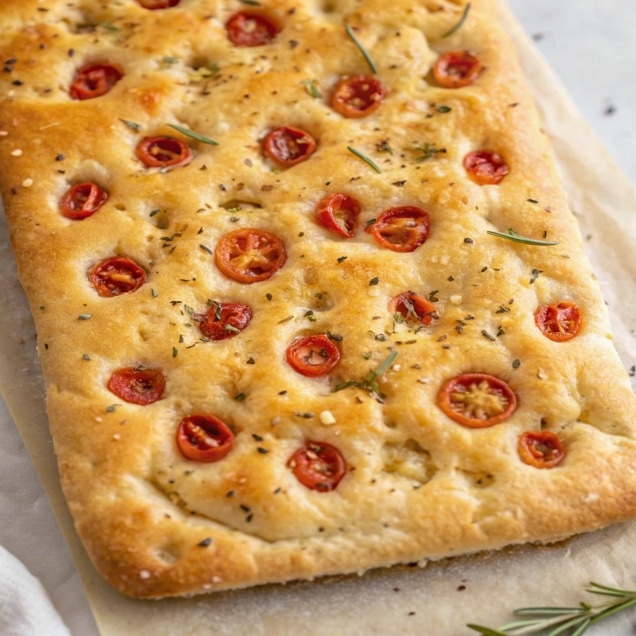If you’ve ever wondered whether gluten-free bread can be just as pillowy and flavorful as its wheat-based cousin, I promise—it can. This focaccia gluten-free bread recipe is my go-to when I want something rustic yet tender, with that irresistible olive oil crust. I’ve been making focaccia for years, but when I first started baking gluten-free, I had to re-learn everything. The reward? A loaf that’s golden, aromatic, and perfect for tearing apart with friends at the table. In this guide, I’ll walk you through every step so you can have a pan of warm, fragrant focaccia in your own kitchen.

Table of Contents
Why You’ll Love This Gluten-Free Focaccia
The Unique Texture and Flavor of Gluten-Free Focaccia
This rustic gluten-free focaccia is my go-to when I want something hearty, aromatic, and satisfying. It’s an Italian gluten-free bread that works for any occasion—whether you’re serving it with a family dinner or enjoying it on its own. I love making a variation similar to my focaccia bread with garlic for an extra flavor boost. Unlike store-bought loaves, this homemade focaccia without gluten stays soft for days and pairs perfectly with soups, salads, or as the base for focaccia sandwiches.
Benefits of Homemade Gluten-Free Bread
Store-bought gluten-free breads can be dense or overly dry, but homemade lets you control every element—hydration, seasoning, and toppings. It’s more affordable than specialty bakery loaves, too. Plus, when you bake it yourself, you can experiment with flavors—think rosemary and sea salt, or even adapting the base for focaccia sandwiches. Fresh from the oven, the taste is unmatched.
Ingredients for the Best Gluten-Free Focaccia
When making this recipe, I choose a flour blend that creates a tender crumb while keeping it a dairy-free focaccia by relying solely on olive oil for richness. It’s essentially an olive oil bread gluten-free lovers will adore. My experience creating cottage cheese bagels gluten-free recipe taught me how structure matters in gluten-free baking. I use instant yeast because, like a no-knead gluten-free bread, it simplifies the process and saves time. For flavor, rosemary is classic, but za’atar or oregano make it a Mediterranean gluten-free bread delight.
Choosing the Right Gluten-Free Flour Blend
The flour blend is the foundation of your focaccia. I recommend one that combines rice flour, tapioca starch, and a touch of sorghum or millet flour for flavor depth. A good all-purpose gluten-free flour with xanthan gum or guar gum works perfectly too.
Is Instant Yeast the Same as Active Dry Yeast?
Instant yeast and active dry yeast aren’t used in quite the same way. Instant yeast can be added straight to your dry ingredients, while active dry yeast must be dissolved in warm liquid before mixing into the dough.
Ingredients List:
- 3 cups (360g) gluten-free all-purpose flour blend (with xanthan gum)
- 2 tsp instant yeast
- 1 ½ cups (360ml) warm water
- ¼ cup (60ml) extra virgin olive oil, plus more for drizzling
- 1 tsp sugar or honey
- 1 ½ tsp fine sea salt
- 2 tbsp fresh rosemary (or 1 tbsp dried)
- Flaky sea salt for topping
- Optional: sliced cherry tomatoes, caramelized onions, or roasted garlic for variations
How to Make Gluten-Free Focaccia – Step-by-Step
This is an easy gluten-free bread method—no complicated shaping, just mix, proof, and bake. After combining the ingredients, I sometimes add roasted garlic for depth. Proofing the dough in olive oil ensures it gets that signature crust found in the best rustic gluten-free focaccia recipes.
Preparation and Mixing Techniques
- Mix the dry ingredients – In a large mixing bowl, whisk together your gluten-free flour blend, instant yeast, sugar, and fine sea salt.
- Add the wet ingredients – Pour in the warm water and olive oil.
- Combine until smooth – Mix with a sturdy spoon or a stand mixer fitted with the paddle attachment until the dough is evenly hydrated and smooth.
- Optional flavor boost – Fold in extras like caramelized onions or roasted garlic.
Proofing and Baking for Perfect Texture
- Prepare the pan – Generously oil a baking pan, then scrape the dough into it. Spread gently to the edges with oiled hands or a spatula.
- Let it rise – Cover with a clean kitchen towel and proof in a warm, draft-free spot until slightly puffy, about 45–60 minutes.
- Preheat the oven – Set your oven to 400°F (200°C) while the dough finishes proofing.
- Add the signature look – Drizzle the top with more olive oil, then press your fingertips into the dough to create dimples.
- Top and bake – Sprinkle with fresh rosemary and sliced cherry tomatoes. Bake for 25–30 minutes, until golden with crisp edges.
- Cool before slicing – Let the focaccia rest for 10 minutes so the crumb can set before cutting.


Focaccia Gluten-Free Bread Recipe
- Total Time: 1 hour 30 minutes
- Yield: 8 servings 1x
Description
A rustic gluten-free focaccia with a golden crust, soft crumb, and rich olive oil flavor. This easy, dairy-free, no-knead bread is perfect for any meal, from family dinners to Mediterranean spreads.
Ingredients
3 cups (360g) gluten-free all-purpose flour blend (with xanthan gum)
2 tsp instant yeast
1 ½ cups (360ml) warm water
¼ cup (60ml) extra virgin olive oil, plus more for drizzling
1 tsp sugar or honey
1 ½ tsp fine sea salt
2 tbsp fresh rosemary (or 1 tbsp dried)
Flaky sea salt for topping
Optional: sliced cherry tomatoes, caramelized onions, or roasted garlic
Instructions
1. Whisk together the gluten-free flour blend, instant yeast, sugar, and fine sea salt in a large mixing bowl.
2. Pour in warm water and olive oil, then mix until smooth. Dough will be sticky—this is normal.
3. Optional: Fold in roasted garlic or caramelized onions for extra flavor.
4. Generously oil a baking pan, scrape the dough in, and spread gently.
5. Cover with a towel and let proof until slightly puffy (45–60 minutes).
6. Preheat oven to 400°F (200°C).
7. Drizzle dough with olive oil, press fingertips to make dimples, and sprinkle with rosemary and flaky sea salt.
8. Bake for 25–30 minutes until golden and crisp at the edges.
9. Cool for 10 minutes before slicing.
Notes
For dairy-free focaccia, use olive oil as the only fat.
This recipe freezes well for up to 3 months; thaw and reheat before serving.
Perfect as table bread, sandwich bread, or part of a Mediterranean spread.
- Prep Time: 15 minutes
- Cook Time: 30 minutes
- Category: Bread
- Method: Baking
- Cuisine: Italian
Nutrition
- Serving Size: 1 slice
- Calories: 180
- Sugar: 1g
- Sodium: 320mg
- Fat: 7g
- Saturated Fat: 1g
- Unsaturated Fat: 6g
- Trans Fat: 0g
- Carbohydrates: 28g
- Fiber: 2g
- Protein: 3g
- Cholesterol: 0mg
Tips for Success
I treat this dough like a no-knead gluten-free bread—keeping it wetter for a softer crumb. Using olive oil generously not only prevents sticking but makes it the ultimate olive oil bread gluten-free fans crave. Keeping a consistent temperature ensures you get the light, airy texture that makes this a standout among Italian gluten-free bread recipes.
Hydration Levels and Dough Handling
- Keep the dough slightly sticky – Gluten-free dough should be wetter than wheat dough; that extra hydration helps create a tender texture.
- Use oiled hands or tools – Instead of adding more flour (which can make the bread dry), oil your hands and spatula to handle the dough easily.
- Don’t overmix – Once everything is combined and smooth, stop mixing to avoid breaking down the dough structure.
Baking Time and Temperature Control
- Check your oven temperature – Use an oven thermometer to make sure 400°F (200°C) is accurate; underbaking can make the center gummy.
- Rotate the pan halfway through baking – This ensures even browning, especially if your oven has hot spots.
- Listen for the crust – When the focaccia is done, it should sound hollow when tapped on the bottom.

Troubleshooting Common Issues
Even with the best focaccia gluten-free bread recipe, things don’t always go perfectly. Here’s how I fix the most common hiccups in my own kitchen.
Why Is My Dough So Soft?
Focaccia dough naturally has a high water content, which means it will feel soft and sticky. Add gluten-free flour into the mix, and it might have you questioning whether you’re making bread or cake. The key is to trust the process—there’s no tricky shaping involved, so just let the dough work its magic. It will come out beautifully in the end.
Why Did My Focaccia Stick to the Pan?
If your focaccia clung to the pan, it’s likely a sign that you didn’t use enough olive oil. Be generous—coat the pan well and brush the top of the dough, too. This not only prevents sticking but also gives the crust its signature flavor and golden color.
Serving and Pairing Suggestions
One of the best things about this focaccia gluten-free bread recipe is how versatile it is. Whether you’re serving it fresh from the oven or the next day, there are so many delicious ways to enjoy it.
How to Serve Focaccia as a Side or Main Dish
- Classic table bread – Serve warm slices with a small dish of extra virgin olive oil and balsamic vinegar for dipping.
- Sandwich base – Split a square of focaccia and fill it with roasted vegetables, fresh greens, and cheese, much like the flavors I use in focaccia sandwiches.
- Soup companion – Pair a hunk of focaccia with tomato soup, minestrone, or lentil stew for a cozy meal.
- Appetizer bites – Cut into small squares, top with a dollop of pesto or tapenade, and serve as party snacks.
Best Drinks and Meals to Pair With Focaccia
- With coffee – Yes, savory bread and coffee work—especially for brunch alongside eggs or a veggie frittata.
- Mediterranean spread – Serve with hummus, olives, grilled vegetables, and a fresh salad for a complete gluten-free feast.
- Pizza-style twist – For something fun, adapt the dough like I do in my pizza focaccia bread and pair with sparkling water or lemonade.
How to Store Gluten-Free Focaccia
Fresh focaccia is irresistible, but if you have leftovers from this focaccia gluten-free bread recipe, proper storage will keep it soft and flavorful for days.
- Cool completely before storing – Trapping steam will make the crust soggy, so let the bread rest on a wire rack until fully cooled.
- Room temperature storage – Wrap in parchment paper or place in a paper bag, then store inside an airtight container for up to 2 days. This prevents it from drying out without losing the crust’s texture.
- For longer storage – If you know you won’t finish it quickly, keep it in the fridge wrapped in foil or in an airtight container for up to 5 days. Warm it in the oven at 350°F (175°C) for 5–7 minutes before serving to refresh the texture.
- Avoid plastic wrap alone – It traps too much moisture and can make the crust rubbery.
Can I Freeze This Recipe?
Yes—you can absolutely freeze this focaccia gluten-free bread recipe, and it still tastes wonderful after reheating. Here’s how I do it:
- Cool completely – Never freeze warm bread; it can form ice crystals that affect texture.
- Portion before freezing – Slice the focaccia into serving-sized pieces so you can thaw only what you need.
- Wrap well – Use parchment paper between slices to prevent sticking, then wrap tightly in foil or place in a freezer-safe bag.
- Freeze for up to 3 months – Gluten-free breads are best enjoyed sooner rather than later, so don’t let it sit in the freezer too long.
- Reheat for best texture – Thaw at room temperature, then warm in the oven at 350°F (175°C) for 5–8 minutes to bring back its softness and crisp edges.
FAQs – Gluten-Free Focaccia Bread
Can I Use Gluten-Free Flour for Focaccia?
Yes! In fact, this recipe is designed as a gluten-free flatbread recipe. The key is to use a well-balanced flour blend that includes rice flour for lightness, tapioca starch for chew, and either xanthan gum or guar gum for structure. This combination gives you a homemade focaccia without gluten that’s still soft, airy, and flavorful.
Can I Use This Focaccia to Make Pizza?
Absolutely! You can top the dough after it’s risen and bake it like a pizza, or bake the focaccia first, then add sauce and toppings before returning it to the oven to melt the cheese. It’s a deliciously versatile base for endless combinations.
What Is the Secret to Making Good Gluten-Free Bread?
For me, the secret is hydration and patience. A higher water content creates a tender crumb, much like a no-knead gluten-free bread, and proper proofing lets the yeast develop flavor. Olive oil also makes a big difference, adding richness and helping form that beautiful crust you expect from an olive oil bread gluten-free recipe.
What Is the Secret to Great Focaccia?
It’s all about the olive oil and toppings. Generous drizzles of extra virgin olive oil keep the bread moist and enhance its flavor, while fresh herbs, roasted garlic, or tomatoes turn it into something special. Even in a dairy-free focaccia like this, the oil and herbs give it that signature Italian flair found in authentic Italian gluten-free bread recipes.
Can I Make Focaccia Bread Without Bread Flour?
Absolutely. This vegan gluten-free focaccia uses a custom gluten-free blend instead of bread flour, and you’ll still get a tender, airy texture. The trick is in the mix—balancing starches and whole-grain gluten-free flours so the bread holds its shape while staying soft inside.
Conclusion – Your Perfect Focaccia Awaits
Baking this focaccia gluten-free bread recipe isn’t just about making bread—it’s about creating something warm, aromatic, and comforting that brings people together. Whether you keep it simple with rosemary and sea salt or turn it into a Mediterranean gluten-free bread topped with roasted vegetables, the result will always be delicious.
This loaf is proof that a homemade focaccia without gluten can be just as satisfying as traditional wheat-based breads. The golden crust, tender crumb, and rich olive oil flavor make it perfect for everything from weeknight dinners to special gatherings.
So grab your mixing bowl, drizzle that olive oil generously, and trust the process. In less than a couple of hours, you’ll be pulling a pan of rustic gluten-free focaccia from the oven—ready to slice, share, and enjoy.
Want more sweet inspiration? Follow me on Facebook and Pinterest where I share cozy, easy-to-make baking recipes just like this one. Every bite is a warm hug. Let’s bake something beautiful together.
